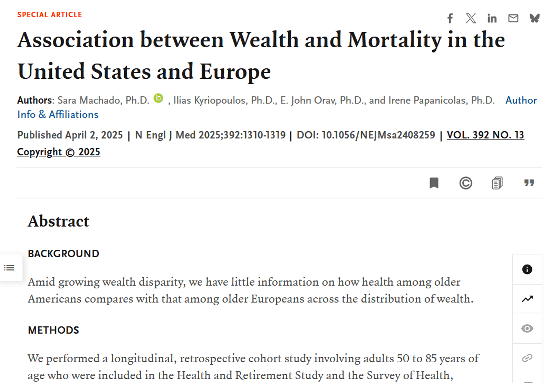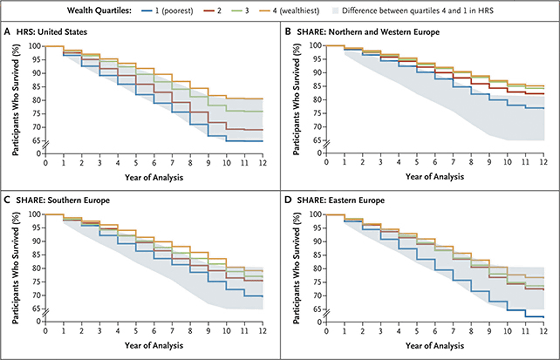Even the wealthiest Americans live shorter lives than the poorest Europeans, study finds

Although the United States is one of the world's leading economic powers, the health of its people is poor, and a 2024 study reported that
Association between Wealth and Mortality in the United States and Europe | New England Journal of Medicine
https://www.nejm.org/doi/full/10.1056/NEJMsa2408259

Even the richest Americans face shorter lifespans than their European divisions, study finds | Brown University
https://www.brown.edu/news/2025-04-02/wealth-mortality-gap
Not Even America's Richest Live as Long as Some of Europe's Poorest : ScienceAlert
https://www.sciencealert.com/not-even-americas-richest-live-as-long-as-some-of-europes-poorest
It is generally believed that a person's socioeconomic status affects their health, and a 2020 study of 25,000 elderly people showed that the wealthier they are, the longer their health life expectancy . In addition, the area where people live is also one of the factors that affect their health, and a study conducted in the United States also reported that 'there is a gap in average life expectancy depending on the area you live in, and that gap is widening.'
There are clear regional disparities in life expectancy, and these disparities are gradually widening - GIGAZINE

An international research team from Brown University in the United States and the London School of Economics in the United Kingdom has conducted a new study on the economic situation and life expectancy of middle-aged and older people living in the United States and European countries.
The study analyzed data from more than 73,000 middle-aged and elderly people aged 50 to 85 years old collected from 2010 to 2022 in the US Health and Retirement Study and the Europe's Survey of Health, Ageing and Retirement . The subjects were divided into four groups of 25% each, from the richest to the poorest, and their health and healthy life expectancy were calculated based on the proportion of subjects in each group who died during the study period.
The analysis confirmed that wealthier people in both the US and Europe tend to have a lower risk of death and a longer life expectancy, although statistics showed that the survival gap between the richest 25% and the poorest 25% was much larger in the US than in European countries.
The graph below shows the survival rate of each group divided into four by wealth on the vertical axis and the number of years since the start of the survey on the horizontal axis, with the top left being the United States, the top right being Northern Europe and Western Europe, the bottom left being Southern Europe, and the bottom right being Eastern Europe. In all countries, the poorest 25% group (blue) has a low survival rate, while the richest 25% group (orange) has a high survival rate, but the difference is particularly large in the United States.

And while mortality rates varied across European countries, the poorest 25% of people living in Western European countries, such as Germany, France, and the Netherlands, had a lower mortality rate than the richest 25% of people living in the United States.
The study found that people in Northern and Western Europe were 40% less likely to die than their American peers, while Southern Europeans were 30% less likely to die, and Eastern Europeans were 13-20% less likely to die than their American peers.
Furthermore, in the United States, poor and unhealthy people are more likely to die early, while the proportion of wealthy and healthy people increases as people get older, a phenomenon known as the 'survivor effect.' This phenomenon makes it appear numerically that 'wealth inequality is shrinking as people get older,' but in reality it's just that poor people are dying.

The results could be explained by European countries having better access to health care and social services and stronger social structures than the U.S. 'The findings are a stark reminder that even the wealthiest Americans are not protected from the systemic problems in the U.S. that contribute to declining life expectancy, including economic inequality and risk factors such as stress, diet and environmental hazards,' said Eileen Papanikolas, a health economist at Brown University.
'Other countries are doing better, so we can learn from that and improve,' said Sara Machado, a researcher at Brown University's Center for Health System Sustainability. 'It's about addressing factors that we're overlooking, not necessarily increasing spending, and it could have much bigger benefits than we realize.'
in Science, Posted by log1h_ik